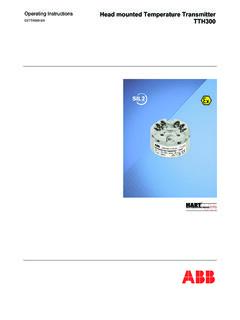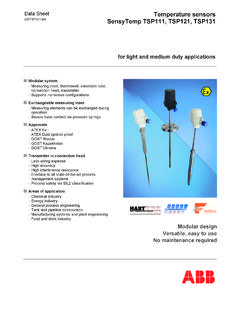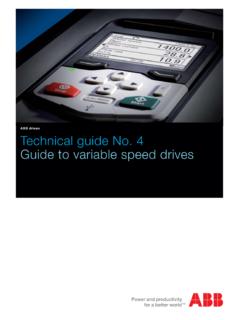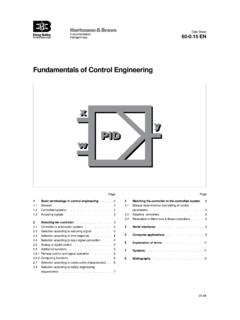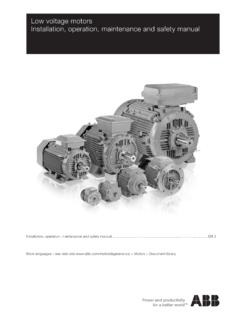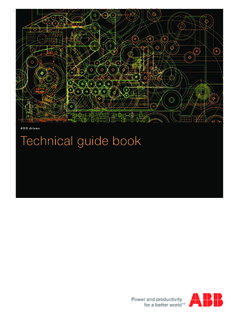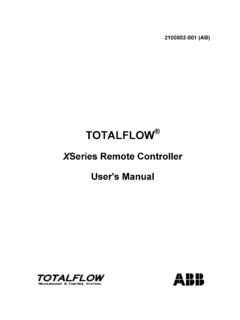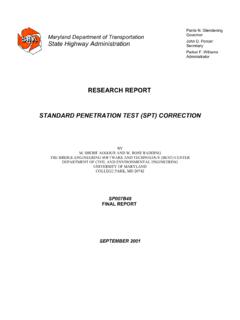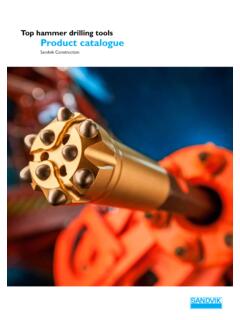Transcription of Emergency Stops - ABB
1 Train5ing Guide No. 2. Emergency Stops A guide to ABB's Emergency Stop Devices ABB. ABB Training Manual No. 2: Emergency Stops 1. Contents 1. Introduction 3. Objectives .. 3. Using this guide .. 3. 2. Basic Training 4. Product definition 4. Terminology . 4. Applicable industries & markets .. 4. Product description .. 5. Color coding & marking standards .. 5. 3. Requirements & Specifications 6. Standards .. 6. I. General standards .. 6. ISO 13850 . 6. EN418 6. II. Design, function, & testing . 7. IEC 60947-1 .. 7. IEC 60947-5-1 .. 7. IEC 60947-5-5 .. 7. UL50 (NEMA Ratings) . 8. UL746C . 9. III. Installation 9. IEC 60204-1 . 9. 4. ABB's Product Scope .. 10. Introduction .. 10. Modular range . 10. Compact range 12. Assembled stations & enclosures 14. A complete range of pilot devices 15. 5. Tools and Resources .. 16. Catalogs 16. Sales literature.
2 16. 6. Quiz .. 18. Appendix . 19. Modular technical sheets .. 19. Compact technical sheets . 21. Dimensions .. 22. NEMA rating definitions . 23. ABB Training Manual No. 2: Emergency Stops 2. Section 1 - Introduction Objectives The purpose of this guide is to reinforce the basic aspects of ABB's Emergency Stop product offering. This includes the following: Understand fundamental Emergency Stop terminology Awareness of certifications and regulations for Emergency Stops Understand the two product ranges offered by ABB. and when to use which range. Make educated sales recommendations Learn where to find Emergency Stop and other pilot device tools and resources available from ABB. Using this guide This guide has been designed to give a thorough overview of Emergency Stop devices, both as a general industrial product, and also as a quality ABB offering.
3 If you are new to the industry, please begin with Section 2, which is a basic training on Emergency Stop devices. If you have experience with these products, you may skip to Section 3, which begins the description of many of the requirements that our product must meet in order to officially quality as Emergency Stop Devices. ABB Training Manual No. 2: Emergency Stops 3. Section 2 Basic Training Product definition An Emergency Stop is defined as a fail-safe control switch or circuit that, when de-energized, will stop the operation of associated equipment and will shut off all potential hazards outside the main power enclosure. Emergency Stops , or E- Stops , are a special type of pilot device that perform the Emergency shutdown operation on a machine or electrical system. E- Stops are different from a typical OFF button in that they must pass a rigorous line of testing and meet a long list of specifications.
4 Many of these specifications will be described later in this manual. Terminology Knowledge of some basic pilot device terminology will help you gain a better understanding of Emergency Stop devices: Contact The conducting part of a switch that makes or breaks a circuit. Available as normally open (NO), in which the circuit is open in its neutral state, or normally closed (NC), in which the circuit will be closed. Activation of the operator will reverse the neutral state of the contact. Contact block The part of a pilot device that encapsulates the contact. Blocks are held to the back of a device with a contact block holder. Operator/Actuator The part of the device that is touched to operate, , the pushbutton head. Applicable Emergency Stop devices can be found in any industry and industries & we really mean anywhere: industrial manufacturing, commercial industries, and even public facilities.
5 They are markets not only important to the safety of the machinery and people in an industrial environment, but they are also quite often required to be present, usually within the line of sight of workers. Furthermore, several E- Stops may be necessary to control a single machine, as they are commonly required to be mounted as frequently as every 6 feet along a production line! Some of many industries with Emergency Stop needs: Material handling packaging, moving, Oil & gas mining/extracting, refining, processing Food & beverage packaging, distribution HVAC(R). Water/waste water Manufacturing automotive/heavy equipment, marine/aviation, glass & plastics Metals mining, refining, processing, forming Commercial applications Amusement park rides And many, many more! ABB Training Manual No. 2: Emergency Stops 4. Product Emergency Stops are available in many shapes and sizes description based on their functionality and application.
6 Both IEC and NEMA standards dictate some of the requirements for Emergency Stops . In addition, many markets and industries have their own industry-accepted specifications, which may call for more specific requirements to be met. For example, the Semiconductor Manufacturing Industry requires that Emergency Stop buttons be mushroom shaped. Some basic products and their applications are listed below: Emergency Stop The red button that a human operator can activate to de-energize a control circuit. Shroud or Guard A collar that surrounds a pilot device, to prevent inadvertent activation. Enclosure A protective box (plastic or metal) that encloses the contacts of a control switch. E-stop enclosures are usually yellow to indicate their Emergency . importance. These are rated according to the amount of protection they provide (dust, water, oil, etc.)
7 E-Stop Station An enclosure assembly including the E-Stop button, which can be mounted onto any surface where an Emergency off switch should be located. The three most common types of Emergency Stops are: Push-pull the operator is pushed in and locks into stop; released by pulling back. Indicated by the circle symbol on the head. Twist-release the operator is pushed in and locks into stop, released by twisting. Indicated by the circular arrows on the head. Key-release - the operator is pushed in and locks into position to stop; released only with a key. Color coding Most standards and specifications require that a true Emergency Stop be a red button. In addition, it is often required that the button be located on a yellow background. These colors indicate that the device is an Emergency control. ABB Training Manual No. 2: Emergency Stops 5.
8 Section 3 Requirements & Specifications Standards ABB's E-Stop products are tested and approved according to: IEC: IEC 60947-5-1 and 60947-5-5. EN: EN 50013, 418, 60947-1, 60947-5-1. UL: UL 508 (File# E76003). CSA: No. 14. CCC. cULus Marine Classifications: GOST, DNV, GL, RMRS, RRR. Certificates for major approvals are available online. Please visit our website at , and navigate to the Pilot Devices page (further instructions can be found in Section 5 of this manual);. or contact Technical Support at (888) 385-1221. An overview of the standards applicable to Emergency Stops : I. General Standards II. Design, Function & Testing III. Installation IEC 60947-1 IEC 60204-1. ISO 13850 IEC 60947-5-1. EN 418 IEC 60947-5-5. I. General ISO 13850 / Standards Gives requirements for the Emergency stop function of a machine, whatever the energy used may be: Once the Emergency stop command has been generated during actuation of the Emergency Stop device, the command shall be maintained by latching means.
9 The Emergency stop command shall be maintained until the device is reset (disengaged). It shall not be possible for the device to engage without generating the stop command. [paraphrased]. In case of a failure in the Emergency stop device (including the engagement means), generation of the stop command shall have priority over the engagement means. [paraphrased]. EN418 / Gives requirements for the Emergency stop function of a machine (EN418 / corresponds to ISO 13850 / ). In addition to the ISO 13850 requirements above, EN418 more specifically states: Any action on the device which results in generating the Emergency stop command shall also result in the latching-in of the device so that when the action on the device is discontinued, the Emergency stop command continues to be maintained until the control device is reset (unlatched). [paraphrased].
10 ABB Training Manual No. 2: Emergency Stops 6. II. Design, IEC 60947-1 Low Voltage Switchgear and Control Gear: General function & Rules testing This is the general standard giving requirements for all low voltage control gear. Requirements specific to E- Stops are found a few sections later in the IEC 60947 document. IEC 60947-5-1 Control-Circuit Devices and Switching Elements, Electromechanical Control Circuit Devices This specifies the electrical characteristics of electromechanical control circuit devices. IEC60947-5-5 Control-Circuit Devices and Switching Elements, Electrical Emergency Stop Device with Mechanical Latching Function The present IEC 60947-5-5 deals specifically with Emergency Stop devices with a mechanical latching function and gives electrical and mechanical requirements in addition to those given in previously described International Standards (ISO 13850, IEC 60204-1, IEC.)
